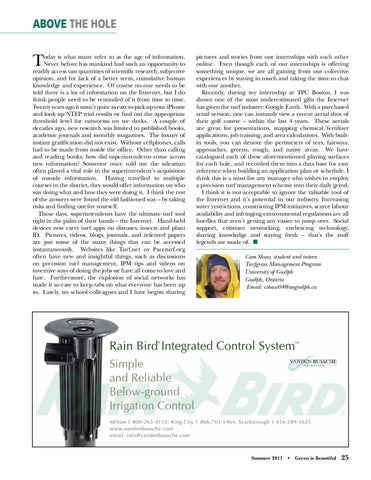ABOVE THE HOLE
T
oday is what many refer to as the age of information. Never before has mankind had such an opportunity to readily access vast quantities of scientific research, subjective opinion, and for lack of a better term, cumulative human knowledge and experience. Of course no one needs to be told there is a lot of information on the Internet, but I do think people need to be reminded of it from time to time. Twenty years ago it wasn’t quite as easy to pick up your iPhone and look up NTEP trial results or find out the appropriate threshold level for cutworms on tee decks. A couple of decades ago, new research was limited to published books, academic journals and monthly magazines. The luxury of instant gratification did not exist. Without cellphones, calls had to be made from inside the office. Other than calling and reading books, how did superintendents come across new information? Someone once told me the salesman often played a vital role in the superintendent’s acquisition of outside information. Having travelled to multiple courses in the district, they would offer information on who was doing what and how they were doing it. I think the rest of the answers were found the old fashioned way – by taking risks and finding out for yourself. These days, superintendents have the ultimate turf tool right in the palm of their hands – the Internet. Hand-held devices now carry turf apps on diseases, insects and plant ID. Pictures, videos, blogs, journals, and refereed papers are just some of the many things that can be accessed instantaneously. Websites like Turf.net or Paceturf.org often have new and insightful things, such as discussions on precision turf management, IPM tips and videos on inventive ways of doing the jobs we have all come to love and hate. Furthermore, the explosion of social networks has made it so easy to keep tabs on what everyone has been up to. Lately, my school colleagues and I have begun sharing
pictures and stories from our internships with each other online. Even though each of our internships is offering something unique, we are all gaining from our collective experiences by staying in touch and taking the time to chat with one another. Recently, during my internship at TPC Boston, I was shown one of the most underestimated gifts the Internet has given the turf industry: Google Earth. With a purchased retail version, one can instantly view a recent aerial shot of their golf course – within the last 4 years. These aerials are great for presentations, mapping chemical/fertilizer applications, job training, and area calculations. With builtin tools, you can denote the perimeters of tees, fairways, approaches, greens, rough, and native areas. We have catalogued each of these aforementioned playing surfaces for each hole, and recorded them into a data base for easy reference when building an application plan or schedule. I think this is a must for any manager who wishes to employ a precision turf management scheme into their daily grind. I think it is not acceptable to ignore the valuable tool of the Internet and it’s potential in our industry. Increasing water restrictions, constricting IPM initiatives, scarce labour availability and infringing environmental regulations are all hurdles that aren’t getting any easier to jump over. Social support, constant networking, embracing technology, sharing knowledge and staying fresh – that’s the stuff legends are made of. ■ Cam Shaw, student and intern Turfgrass Management Program University of Guelph Guelph, Ontario Email: cshaw04@uoguelph.ca
Summer 2011 • Green is Beautiful 25
